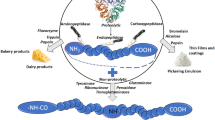Abstract
Activity within the food and manufacturing industries is based on factors that affect the state of the food market and improve the quality of life. A subject of inquiry for scientists who work in this sphere is systems of transforming plant and animal raw materials into foods. In the course of production, the nutrition and energy value of foods, their safety for humans and the environment, and consumer properties are controlled. The success of studies is determined by the multidisciplinary approach, perfectly interfacing different scientific trends—medicine, biology, physics, chemistry, agriculture, etc.
Similar content being viewed by others
References
K. J. Locey and J. T. Lennon, “Scaling laws predict global microbial diversity,” Proc. Natl. Acad. Sci. U. S. A. 113 (21), 5970–5975 (2016).
L. M. Aksenova, A. Ya. Aleinikova, and G. O. Magomedov, Pastry Technology (Izd. RAPP, St. Petersburg, 2010) [in Russian].
Promising Enzymic Preparations and Biotechnological Processes in Food and Feed Technologies, Ed. by V. A. Polyakova and L. V. Rimareva (Tip. Rossel’khozakademii, Moscow, 2016) [in Russian].
G. Mogensen, S. Salminen, J. O’Brien, et al., “Food microorganisms—health benefits, safety evaluation and strains with documented history of use in foods,” Bull. Int. Dairy Fed. 377, 4–19 (2002).
L. V. Rimareva, M. B. Overchenko, E. M. Serba, et al., “Attenuation of concentrated grain wort by an osmophilic race of the alcohol yeast Saccharomyces cerevisiae 1039,” Proizvodstvo Spirta Likerovodochnykh Izdelii, No. 3, 10–12 (2011).
E. M. Serba, M. B. Overchenko, and L. V. Rimareva, “Synthesis and secretion of hydrolases of the micromycete Aspergillus oryzae—the producer of enzymes necessary for biocatalysis of grain polymers,” Proizvodstvo Spirta Likerovodochnykh Izdelii, No. 2, 18–20 (2011).
G. S. Volkova, E. V. Kuksova, and L. V. Rimareva, “Identification and selection of Lactococcus lactis cultures for protective and preventive food and feed additives,” Dostizheniya Nauki Tekhniki APK, No. 8, 99–101 (2016).
V. A. Polyakov, L. V. Rimareva, E. I. Kurbatova, et al., “Protein enrichers of food based on enzymatic degradation of the protein–polysaccharidic complex of yeast cell walls,” Pishchevaya Promyshlennost’, No. 11, 42–44 (2012).
A. M. Rozhkova, M. V. Semenova, E. A. Rubtsova, et al., “Creation of a heterologous gene expression system on the basis of Aspergillus awamori recombinant strain,” Appl. Biochem. Microbiol., No. 3, 279–287 (2011).
E. M. Serba, K. V. Rachkov, N. I. Ignatova, et al., “Creating natural biocorrectors of food for functional products,” Pishchevaya Promyshlennost’, No. 9, 18–20 (2013).
V. A. Polyakov, L. V. Rimareva, E. M. Serba, et al., “Biologically active additives of microbial origin as a factor that forms functional properties of food products,” Khranenie Pererab. Sel’khozsyr’ya, No. 12, 43–47 (2013).
E. M. Serba, V. A. Polyakov, L. V. Rimareva, et al., “Biotechnological methods of obtaining food additives based on microbial biomass conversion,” Vopr. Pitan., No. 2, 149–150 (2016).
E. M. Serba, L. V. Rimareva, M. B. Overchenko, et al., “Obtaining fermentolysates of mycelial biomass for the creation of food and feed additives,” Pishchevaya Promyshlennost’, No. 6, 20–23 (2016).
E. V. Orlova, L. V. Rimareva, M. B. Overchenko, et al., “The effect of the yeast fermentolysates Saccharomyces serevisiae on the cell cycle and apoptosis of transplantable tumor cells,” Biozashchita Biobezopasnost’, No. 3, 48–51 (2012).
L. V. Rimareva, G. S. Volkova, and E. V. Kuksova, “Complex organic biopreservatives based on probiotic culture consortia,” Vopr. Pitan., No. 2, 209–210 (2016).
E. M. Serba, M. B. Overchenko, V. E. Davydkina, et al., “Scientific and practical aspects of obtaining BADs based on secondary bioresource conversion,” Khranenie Pererab. Sel’khozsyr’ya, No. 2, 44–50 (2015).
E. M. Serba and V. A. Polyakov, Biotechnological Basics of Complex Processing of Grain Raw Materials and Secondary Bioresources into Ethanol and Protein–Amino Acid Additives (Tipografiya Rossel’khozakademii, Moscow, 2015) [in Russian].
Author information
Authors and Affiliations
Corresponding author
Additional information
Original Russian Text © L.M. Aksenova, L.V. Rimareva, 2017, published in Vestnik Rossiiskoi Akademii Nauk, 2017, Vol. 87, No. 4, pp. 355–357.
Rights and permissions
About this article
Cite this article
Aksenova, L.M., Rimareva, L.V. Directed conversion of protein modules of plant and animal foods. Her. Russ. Acad. Sci. 87, 132–134 (2017). https://doi.org/10.1134/S1019331617020083
Received:
Published:
Issue Date:
DOI: https://doi.org/10.1134/S1019331617020083




